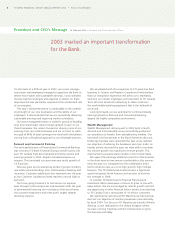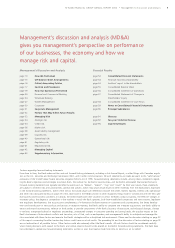TD Bank 2003 Annual Report Download - page 18
Download and view the complete annual report
Please find page 18 of the 2003 TD Bank annual report below. You can navigate through the pages in the report by either clicking on the pages listed below, or by using the keyword search tool below to find specific information within the annual report.TD BANK FINANCIAL GROUP ANNUAL REPORT 2003 • Management’s Discussion and Analysis16
The Bank’s accounting policies are essential to understanding
its results of operations and financial condition. A summary
of the Bank’s significant accounting policies is presented in
Note 1 of the Bank’s Consolidated Financial Statements
beginning on page 59 of this Annual Report. Some of the
Bank’s policies require subjective, complex judgements and
estimates as they relate to matters that are inherently
uncertain. Changes in these judgements or estimates could
have a significant impact on the Bank’s financial statements.
The Bank has established procedures to ensure that accounting
policies are applied consistently and that the processes for
changing methodologies are well controlled and occur in an
appropriate and systematic manner. In addition, the Bank’s
critical accounting policies are reviewed with the Audit
Committee on a periodic basis. Critical accounting policies
that require management’s judgements and estimates include
accounting for loan losses, accounting for the fair value of
financial instruments held in trading portfolios, accounting
for income taxes, the valuation of investment securities,
accounting for securitizations, the valuation of goodwill and
intangible assets and the accounting for pensions and post-
retirement benefits.
Accounting for loan losses
Accounting for loan losses is an area of importance given
the significant size of the Bank’s loan portfolio. The Bank
has three types of allowances against loan losses – specific,
general and sectoral. Loan impairment is recognized when the
timely collection of all contractually due interest and principal
payments is no longer assured. Significant judgement is
required as to the timing of designating a loan as impaired
and the amount of the required specific allowance. Reviews
by regulators in Canada and the U.S. bring a measure of
uniformity to specific allowances recorded by banks. Sectoral
allowances require ongoing judgement as to draw downs
from sectorals to specific loss and the amount of periodic
sectoral allowances required. General allowances also require
judgement given that the level of general allowances
depends upon an assessment of business and economic
conditions, historical and expected loss experience, loan
portfolio composition and other relevant indicators. Note 1(h)
of the Bank’s Consolidated Financial Statements provides
more details.
Accounting for the fair value of financial
instruments held in trading portfolios
The Bank’s trading securities and trading derivatives are
carried at fair value on the Consolidated Balance Sheet with
the resulting realized and unrealized gains or losses recognized
immediately in other income. The fair value of exchange
traded financial instruments is based on quoted market rates
plus or minus daily margin settlements. If listed prices or
quotes are not available, then the Bank’s management
applies judgement in the determination of the fair values by
using valuation models that incorporate prevailing market
rates and prices on underlying instruments with similar
maturities and characteristics, and takes into account factors
such as counterparty credit quality, liquidity and concentration
concerns. Imprecision in estimating these factors can impact
the amount of revenue or loss recorded for a particular
position. Notwithstanding the judgement required in fair
valuing the Bank’s financial instruments, the Bank believes its
estimates of fair value are reasonable given the Bank’s
process for obtaining external market prices, internal model
review, consistent application of approach from period to
period and the validation of estimates through the actual
settlement of contracts.
Accounting for income taxes
Accounting for current income taxes requires the Bank to
exercise judgement for issues relating to certain complex
transactions, known issues under discussion with tax
authorities or transactions yet to be settled in court. As a
result, the Bank maintains a tax provision for contingencies
and regularly assesses the adequacy of this tax provision.
Future income taxes are recorded to account for the effects
of future taxes on transactions occurring in the current
period. The accounting for future income taxes also requires
judgement in the following key situations:
•Future tax assets are assessed for recoverability. The Bank
records a valuation allowance when it believes based on all
available evidence, that it is not more likely than not that
all of the future tax assets recognized will be realized prior
to their expiration. The amount of the future income tax
asset recognized and considered realizable could, however,
be reduced in the near term if projected income is not
achieved due to various factors such as unfavourable busi-
ness conditions.
•Future tax assets are calculated based on tax rates to be
applied in future periods. Previously recorded tax assets
and liabilities need to be adjusted when the expected date
of the future event is revised based on current information.
•The Bank has not recognized a future income tax liability
for undistributed earnings of certain international
operations as it does not plan to repatriate them.
Estimated taxes payable on such earnings in the event of
repatriation would be $206 million at October 31, 2003.
Valuation of investment securities
Under Canadian generally accepted accounting principles
(GAAP), investment securities are carried at cost or amortized
cost and are adjusted to net realizable value to recognize
other than temporary impairment. The determination of
whether or not other than temporary impairment exists is a
matter of judgement. The Bank’s management reviews these
investment securities regularly for possible other than
temporary impairment and this review typically includes an
analysis of the facts and circumstances of each investment
and the expectations for that investment’s performance.
Specifically, impairment of the value of an investment may be
indicated by conditions such as a prolonged period during
which the quoted market value of the investment is less than
its carrying value, severe losses by the investee in the current
year or current and prior years, continued losses by the
investee for a period of years, suspension of trading in the
securities, liquidity or going concern problems of the investee
or a current fair value of the investment that is less than its
carrying value. When a condition indicating an impairment
in value for an investment has persisted for a period of three
to four years, there is a general presumption that there has
been a loss that is other than temporary in nature. This
presumption can only be rebutted by persuasive evidence to
the contrary.
Critical Accounting Policies
























